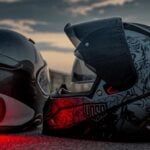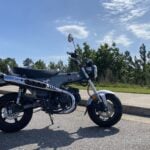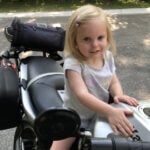Having A Plan When The Ride Goes Awry
Shearer’s Bridge Highway is a nosebleed downhill grade from Oregon’s high plains to the Deschutes River Gorge below. So steep is the descent that it forces the blood to your eyeballs, lips and nose as the motorcycle feels like it is nervously perched on the front wheel. If your house had a driveway this steep, you would try to sell it, but never be able to.
Touring buddies Dave “White Girl” Wensveen and Bill Motsenbocker made the descent ahead of me and had no issue on the downhill. However, a few minutes into our impatient wait for Corey Schubarth, our touring rookie, to appear, I could sense we were living on borrowed peace. I started to worry.
I knew something was wrong. I remounted and ascended the grade slowly. With its rock face to the left and sheer drop to the right, running wide here meant endless airtime to consider what went wrong, get your affairs in order and picture your kids’ faces before gravity pulls you toward your inevitable handshake with the basalt rocks that lie below, eager to mangle rider and bike. A couple of minutes into my climb I found Corey’s wreck. He had run wide.
For those who interchange God’s Divine Intervention with coincidence, here is proof of the former. As Corey descended the highway on his Yamaha FJR, he felt he was using the front brakes too much and decided to use the rear only, with predictably disastrous consequences. I could see the rear tire skid marks pointing to the sharp downhill right hand turn. Deep gouges were cut into the pavement where the frame plowed a furrow into the tarmac. All tracks should have led to a flight into the rocky abyss.
(Editor’s note: I’ve ridden this stretch of tarmac with Ted. I nicknamed it “Butt Pucker Drive” for the very reasons he’s described above.)
Corey’s skid marks pointed to the only dirt mound on the descent. Notice the guard rail to the left and the vast expanse of open air beyond.
However, thanks to God’s Divine Intervention, Corey and his bike hit the only dirt mound on the entire descent. Rider and bike slid on their sides, hit the tall outcropping and ricocheted back onto the road like a wild pitch hitting a backstop and bouncing back to home plate. This was the only dirt mound on the descent and if it were not there, Corey and his bike could have gone airborne.
The bike was in the middle of the road where it had come to rest after its rebound off the dirt mound but Corey, fearing for his safety as he laid in the middle of a blind corner, had managed to drag his injured body to the side of the road and was sitting upright, leaning against the dirt mound, motionless, staring blankly into space.
I pulled over, inhaled deeply and held it to calm my racing thoughts, then exhaled and formulated my plan.
Corey was leaning up against the rock wall to the right. Once I decided he was ambulatory, I moved him to lean against the nearby guardrail since there was more room by the side of the road. Scene safety is paramount in this situation.
What would your plan be? Would you make a plan of what would you do first, second, then third or would you even plan and think in steps? How would you handle bystanders, the motorcycle, and Corey? Any rider can be suddenly thrust into the role of first responder should a buddy go down, yet few plan ahead. If you would like to be better prepared, read on.
To be clear, this article is neither a first aid course nor a replacement for proper first responder training. Those skills require class time, hands-on training and sometimes years of experience. The intent here is to give you a glimpse into the mind of a first responder to see how they think, how they process and how they plan because making decisions in a timely manner can make the difference between an injured rider making full recovery, or not.
NaDean Reinertsen has experience in both endeavors. She holds decades of experience as a paramedic and is also an adventure rider junkie. She got her EMT in 1992, her paramedic in 1998 and discovered motorcycling 5 years ago when she saw that her husband Oliver, a physician’s assistant, could explore farther and faster on his ADV bike than she could on her mountain bike. Though mountain biking was her passion, it has since been replaced by a love affair with her 2020 KTM 790.
NaDean on her 2020 KTM 790. There are basic resources she carries. “I take bandaging supplies, a tourniquet and pain meds for those injuries that are just broken bones because you can make a splint out of anything. But most important is a tourniquet because what is going to kill you? If you lose all of your blood.”
“Working in EMS, people think you’re silly if you ride motorcycles because we see it. I will see a few catastrophic injuries (broken neck, severed limb or death) per year.” When asked to consolidate decades of experience on the medical side and years of ADV riding into one lifesaving piece of advice for fellow riders, her response was bold and simple.
Have a plan.
“The first thing people should be asking themselves,” she said, “should be ‘What’s my plan? If something goes wrong, what’s my plan?’ If you don’t have a first aid kit, then you need to know you don’t have a first aid kit and you decided not to carry it. Do you have a Garmin Spot or a satellite phone or some way to get a hold of somebody? If you don’t, then you need to know that you don’t have that. If you don’t have a plan, then go out there knowing that you don’t have a plan.”
This is where the mind of a first responder differers from the normal mind: they plan. Constantly. Everywhere. Relentlessly. When life goes sideways someone like NaDean has already planned for it, then executes that plan smoothly, boldly and without hesitation because in their head, they have done it already. Here is a more detailed glimpse into the mind of a first responder like NaDean.
“I drive over the mountain pass all the time and I run scenarios in my mind: What would you do in this situation, what would you do in that situation. I just run it through my head first. Even when I work out at the gym I think ‘Do people know where the AED is because it’s over there on the wall.’ I will be like, ‘If this guy next to me collapses, what do I do from there?’ Set yourself up for success. Have a plan.”
Although NaDean’s skill set means her plan would be different than yours, any plan you can prepare and execute is better than chaos. No plan means no decisions happen, time is wasted, resources are underutilized or sometimes not used at all.
NaDean crashes too.
Corey’s aforementioned crash and how it was handled is an example of a plan thought out ahead of time then executed. It may not have been the perfect plan, but it was better than disarray. Here is what happened next.
I pulled my bike to the side of the road beside a wounded Corey, put the kickstand down, killed the motor, took my cleansing breath, then exhaled and put my plan into motion.
First came the most critical aspect of any accident scene: scene safety. If I got run over I couldn’t help Corey. We were on a blind corner with a bike in the middle of the road that would cause drivers to target fixate and avoid the bike by swerving onto the shoulder where Corey and I were parked. Not good. Taking care of scene safety was priority one.
A bystander had driven up and insisted in a panicked tone that we had to pick the bike up.
“No,” I said, “forget about the bike. I want you to go 50 yards up the road with your car and block traffic.” The bystander froze in the confusion of not only having his actions overruled but then given an order from a total stranger. I explained- “If we try to pick up the bike here in the middle of the road and a car drives into us, there will be three victims instead of one. Now go uphill and block traffic.” Either my words made sense or the tone of my voice drove the point home. Regardless, the bystander compiled.
Skid marks from the rear tire followed by gouge marks from the engine case tell the story. Notice the sheriff’s car parked 50 yards uphill for scene safety.
By this time, Mots and White Girl arrived. I sent Mots to the bottom to block traffic for complete scene safety while White Girl stayed as my assistant. With the scene fully secured, I could now turn my attention to Corey. I asked how he was doing.
“Not good,” he replied.
Which was, ironically, a very good response. Just by answering this meant Corey had an airway, was breathing, was conscious and somewhat responsive to his surroundings, all good things. When I asked Corey what happened he could recall everything and was oriented to time and place. After a thorough head to toe check, a hurt shoulder was his only injury. I knew we had cell service and our group knew our location so an ambulance arrived relatively quickly given our remote location. From the initial crash to loading Corey into an ambulance took less than 45 minutes, no one was put at risk by helping Corey and everyone will ride again another day. Everything went according to plan.
Which brings us back to NaDean’s point: have a plan.
NaDean agrees that a feature like this is not a replacement for proper medical training. “How do you identify life threatening injuries?” she reflected. “That’s a whole class.” First aid courses are always useful and emergency medical training is out there for any rider willing to seek it.
Having those skills will change how you pack, how you think, and how you plan. You will do things like memorize highway numbers, remember the last time you had cell reception, count mile markers as they go by so you can report your exact location, look for the AED when you enter a restaurant and know who in your group has a peanut allergy and if they carry an Epipen. In summary, you will begin to plan.
Then, when the day goes sideways, you will hear NaDean’s words echoing in your helmet.
“Know what you are doing,” she states. “What’s your plan?”
Ted
*Story photos by Dave Wensveen. Header photo by MCN




























Good read!! Always a definite must to walk around with a plan in your pocket!!
Or in the saddlebag, tail bag, or tank bag! Online looking at compact First Aid kits even as I type this,
I was hit by a car 13 months ago. Fractured hip, compound femur fracture and multiple foot fractures. A school bus driver blocked the road from one direction and another driver stopped vehicles from the other direction. The bus driver was holding my hand telling me to stay calm when I woke up. He then told me the EMS was on their way. Everything worked out because so many bystanders took action and the correct action. After 3 leg surgeries and 4 weeks in the hospital I got home in a wheelchair and started planning the repair of my bike and how to build a sidecar for it which I did from my wheelchair. I have now put about 150 miles on my rig and looking forward to warmer weather and more miles.
What an amazing story you have, Brian! Mirrors my own, in many ways. I too was hit by a car while riding, way back in 2001. Multiple fractures in both legs, multiple surgeries, many months in hospitals and rehab. Never thought I’d walk right again, much less ride. But here I am, all these years later, still riding, traveling America and the world. I am, among men, very blessed. Much thanks goes to several motorists who acted immediately, blocking traffic both ways, securing the scene, securing me, until help arrived. People with a plan, who act when needed, indeed make a difference.
Thanks for sharing your story, Brian. Prayers and blessings for a full recovery. Correspond with us: Rob@roaddirt.tv